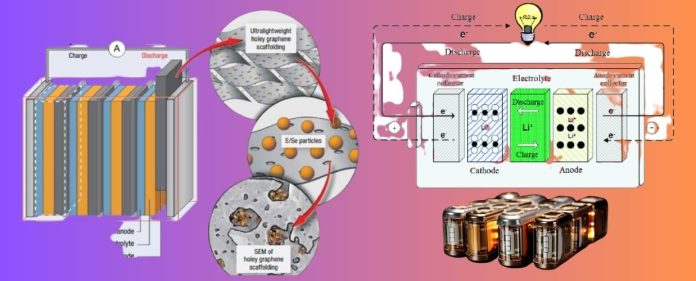In pursuing more efficient, safer, and sustainable energy storage solutions, solid-state batteries have emerged as a groundbreaking technology with the potential to revolutionize multiple industries. As the world transitions towards cleaner energy sources and grapples with the challenges of electrification and decarbonization, solid-state batteries offer a promising avenue for addressing key limitations of traditional lithium-ion batteries. This article explores the intricate workings of solid-state batteries, their advantages, challenges, and the transformative role they can play in shaping the future of energy storage.
A Paradigm Shift in Battery Technology
Solid-state batteries represent a significant leap forward in energy storage technology. Unlike conventional lithium-ion batteries that use liquid electrolytes, it employ solid electrolytes, which provide numerous advantages. The electrolyte, a critical component that facilitates the movement of ions between the cathode and anode, is a solid material in these batteries. This design innovation eliminates the need for flammable and potentially hazardous liquid electrolytes, addressing safety concerns and enabling the development of high-energy-density batteries.
This fundamental shift in battery design is the result of meticulous scientific research and engineering ingenuity. By replacing the liquid electrolyte with a solid counterpart, we unlock a range of benefits that extend beyond energy storage, touching sectors such as electric vehicles, renewable energy integration, and portable electronics.
The Advantages of Solid-State Batteries
It offer a multitude of advantages that position them as a promising successor to traditional lithium-ion batteries.
Enhanced Safety
Eliminating liquid electrolytes significantly reduces the risk of thermal runaway, which can lead to fires and explosions in conventional batteries. This enhanced safety profile is of paramount importance, particularly in applications like electric vehicles, where safety concerns have been a primary consideration. Solid-state batteries contribute to safer transportation and energy storage solutions.
Higher Energy Density
Solid-state batteries have the potential to achieve higher energy density compared to their liquid electrolyte counterparts. This increased energy density translates to longer-lasting charges and extended driving ranges for electric vehicles, enabling a wider range of applications and improved overall efficiency. It opens new possibilities for energy-intensive applications without compromising on size or weight.
Faster Charging and Discharging
The solid electrolyte’s ability to conduct ions efficiently can lead to faster charging and discharging rates. This characteristic is crucial for electric vehicles and renewable energy systems, where quick energy replenishment and release are essential for optimal performance and grid integration. Solid-state batteries could facilitate rapid charging networks, reducing charging times and improving user convenience.
Wide Operating Temperature Range
Solid-state batteries are less sensitive to temperature fluctuations, making them suitable for extreme environments and climates. They can operate efficiently at both high and low temperatures, providing stable performance even in challenging conditions. This attribute is particularly valuable in regions with diverse climates, where consistent battery performance is essential.
Longer Lifespan
The reduction of dendrite formation, a common issue in liquid electrolyte batteries, can lead to longer battery life spans. This durability is particularly advantageous in applications where frequent cycling and longevity are critical factors, such as grid energy storage and consumer electronics. It reduces the frequency of battery replacements and the associated environmental impact.
Challenges on the Path to Commercialization
While solid-state batteries offer compelling advantages, several challenges must be addressed before they can achieve widespread commercial adoption.
Manufacturing Complexity
Producing solid-state batteries requires precise manufacturing techniques and high-quality materials. Scaling up production and ensuring consistency across large volumes remain challenges that need to be overcome for mass market penetration. Collaborative efforts between researchers, manufacturers, and policymakers are essential to streamline production processes.
Cost Competitiveness
The production of solid-state batteries involves advanced materials and intricate manufacturing processes, which can result in higher initial costs. Achieving cost parity with traditional batteries is essential to make solid-state technology financially viable for various applications. Continued research and technological advancements are crucial to reducing production costs.
Electrolyte Stability
Developing solid electrolytes with robust stability over numerous charge and discharge cycles is a technical challenge. Ensuring that the electrolyte remains structurally and chemically stable is crucial for maintaining long-term battery performance. Scientific breakthroughs and material innovations are necessary to enhance the stability and reliability of solid-state batteries.
Scalability
As solid-state battery technology advances, ensuring scalability to meet increasing demand while maintaining high quality and safety standards is a key consideration. Research, development, and infrastructure investments are necessary to expand production capacity and meet the growing global demand for advanced energy storage solutions.
The Road Ahead Unlocking the Potential
Despite the challenges, the journey toward realizing the full potential of solid-state batteries is well underway. Researchers, scientists, and engineers are collaborating to develop novel materials, improve manufacturing processes, and optimize battery designs. As technology matures and breakthroughs occur, solid-state batteries are poised to play a transformative role in various sectors.
Electric Vehicles (EVs)
Solid-state batteries could revolutionize the EV industry by offering longer ranges, faster charging times, and enhanced safety. EVs equipped with solid-state batteries have the potential to accelerate the adoption of electric mobility and reduce reliance on internal combustion engines. This shift towards electric transportation could significantly contribute to reducing greenhouse gas emissions and air pollution.
Renewable Energy Storage
The stability and efficiency of solid-state batteries make them an ideal candidate for storing excess energy generated from renewable sources like solar and wind. They can help address the intermittent of these sources and facilitate greater grid integration. Solid-state battery storage systems could enhance the reliability and resilience of renewable energy installations.
Consumer Electronics
Solid-state batteries could lead to longer-lasting devices with faster charging capabilities in portable electronics. This would enhance user experience and reduce the environmental impact of battery disposal. Additionally, the extended lifespan of devices could contribute to reducing electronic waste.
Aerospace and Aviation
Solid-state batteries could find applications in aerospace and aviation, where energy density, safety, and reliability are crucial considerations. They could power electric aircraft and space missions, enabling more sustainable and efficient transportation. Solid-state batteries may play a pivotal role in reducing the environmental footprint of air travel and space exploration.
Conclusion: A Solid Foundation for the Future
Solid-state batteries represent a paradigm shift that promises to transform energy storage and shape a more sustainable and electrified future. By reimagining the fundamental components of batteries, we can unlock new horizons of efficiency, safety, and performance. The journey towards widespread commercialization may be challenging, but the rewards are substantial—a cleaner environment, reduced carbon emissions, and a more reliable and efficient energy landscape. As research and development efforts continue to propel solid-state battery technology forward, industries, policymakers, and consumers stand to benefit.
By investing in innovation, supporting collaboration, and embracing emerging technologies, we can build a solid foundation for a future powered by sustainable and efficient energy storage solutions. Solid-state batteries are more than a technological advancement; they are a beacon of hope, lighting the way toward a greener and more electrified world. Through dedication, ingenuity, and collective action, we can harness the full potential of solid-state batteries and usher in a new era of energy storage that powers progress while safeguarding our planet.



